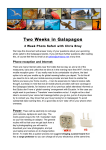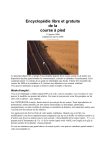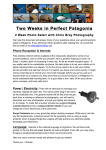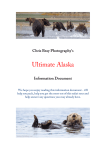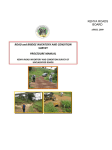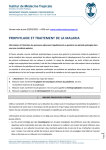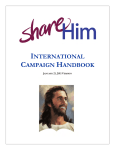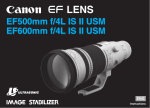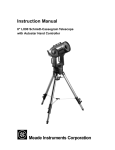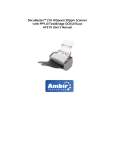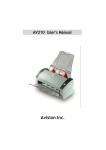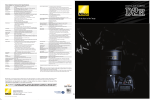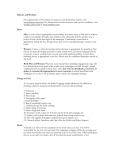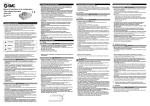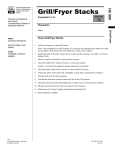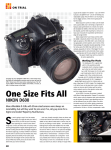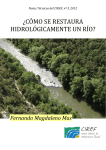Download Ultimate Africa - Kenya Safari Information Document
Transcript
Ultimate Africa – Info Sheet 2 Week Kenya Photo Safari with Chris Bray We hope this document will answer many of your questions about your upcoming photo safari to Kenya. If you still have further questions after reading this, of course feel free to email us at [email protected] at any time. Get excited! GENERAL INFORMATION Travel Visas: Citizens from Australia, Canada, USA, Britain, and EU countries will have no problems obtaining a ‘single-entry’ visa for travel to Kenya. If not from the above countries, you should contact your local Kenyan embassy for details. ‘Single-entry’ Kenyan travel visas last for three months, and can either be organised before you leave home, or purchased upon arrival in Kenya. We recommend pre-organising your visa (which involves contacting your local Kenyan embassy, posting off your passport for them to stamp and post back), simply to prevent any problems or delays once arriving in Kenya. IMPORTANT: If you do intend to purchase your visa upon arrival in Kenya, you MUST have $50 US in cash, in notes dated yr 2000 series or newer, ready to hand over as you pass through immigration. Safety in Nairobi etc: Ok, let’s not over react here. Certainly, compared to Sydney CBD, yes, Nairobi is a dangerous city, but no more so than any other thirdworld centre around which comparatively rich tourists drift. If you are careful, watch your bags like a hawk, and basically don’t take any chances, then you will be perfectly safe! I would not advise to go out into the streets of Nairobi with your camera gear or expensive necklaces around your neck. It is just like any other poor city where opportunistic thieves etc will take advantage of any situation presented to them – so just be alert. It’s best not to use public transport, and don’t wander aimlessly around to find your own ‘taxi’ etc – it’s best to wait in the airport or hotel for your shuttle etc. Once we are travelling in a group, and once when we get out of the city it will be much safer! On safari, we have found everyone to be not only honest and friendly, but surprisingly so. Our clients have accidently left things of value in rooms etc, only to find a porter or cleaner hurrying after them to give it back. Flights to Kenya: We strongly recommend that you book your flights to Kenya through our travel agent Jacqui Smith [email protected]. She has been working with us for over three years now & knows the in’s and out’s of travelling to Kenya and what your best options are depending on what city you are flying from. We recommend that you fly into Nairobi at least one day before the safari starts! That way you can be well rested after your long journey and allow for extra time in the unlikely case your flight gets delayed or you baggage does not arrive. If you would like to book any pre-safari accommodation at the Windsor hotel (this is NOT included in the Safari) please email us (rather than Jacqui) and we can arrange this for you – [email protected] Airport transfer: If you fly out of Nairobi on the last day of the safari, then your airport transfers is included, however your transfer from the airport to the hotel before the safari starts is NOT included in the safari, nor are transfers to the airport if you stay on in Nairobi after the safari finishes. Please contact [email protected] to arrange these transfers. Day Trip’s before/after the Kenya Safari. If you are flying in a couple of days before the safari, or leaving a couple of days after the safari finishes, it might be fun to do a day-trip excursion. We can arrange a car and an English-speaking driver to take you wherever you want to go in Nairobi. You might like to visit the elephant orphanage and the giraffe sanctuary (however, we do visit both of these places on the first day of the safari) or you can go to the markets, museums, shopping centres or wherever you want - you just need to tell the driver. If you are interested in this, please [email protected] with what date(s) you would like to go on, and it’ll cost $60 per/person for a minimum of three people in either a car or mini bus depending on how many people are interested in joining! Travel Insurance: Chris Bray Photography will not be liable for any damage to your camera gear or equipment, nor your personal health or wellbeing. You MUST organise your own travellers insurance for these two weeks & email [email protected] your travel insurance policy once purchased. Remember our travel agent Jacqui, [email protected] is very willing and able to help secure you the best deal here! Twin Share: Accommodation arrangements vary for each location, however it is all twin-share. So, if you're booking on your own, then expect to share a 'tent house' / room with someone else, and if you're booking as a couple, then we can organise a double bed rather than two singles. For solo travellers we can't guarantee that we'll always be able to have you sharing with someone of the same sex - it depends on the gender split, but we do our best. You can request a single supplement (a room to yourself) for an extra $2000 AU. Keep in mind though that a) you're only usually in your rooms to sleep as we fill your waking hours with plenty to do, and b) the couple of times we have had clients get rooms for themselves, they end up regretting it when they see the amazing friendships that form between other roomies. What kind of bags should I bring? Considering as we’ll be traveling around with our bags in the vehicles from time to time between safari camps etc, it’s always best to bring your non-camera gear (clothes etc) in a soft bag such as a duffle-bag or backpack – please don’t bring a rigid suitcase, as they are awkward to stash away. Checked-in Baggage Warning: If you are flying via Johannesburg, it has been recommended that you get your checked-in baggage cling-wrapped (a service available at most airports) to discourage baggage handlers from tampering with your bags. Apparently the general rule should be that (as much as possible), bring all your important stuff with you as carry-on luggage (this includes camera chargers etc – anything that would ruin your safari completely if it was stolen or if your main baggage was delayed etc. Unlikely of course, but it provides peace of mind if you carry your genuine ‘essentials’ with you). Internet: We can pre-organise Internet for you, if you let us know in advance. It cost about 2,500 Shillings (equivalent to about $30 AUD), and works from a small USB stick modem that you simply plug into your laptop and away you go. Amazingly, you will receive Internet reception in just about everywhere we stay, although some places are slower then others! You’ll enjoy your holiday more however, if you leave your work at home, and don’t plan on checking your emails unless you really need to. It’s not everyday you’re in Kenya – enjoy the experience! Phone Reception: As far as mobile reception goes – if you need to be contacted the best option is to set you mobile up to global roaming. To do this all you need to do is call your mobile phone provider and ask them to turn it on before you leave your home country. Amazingly, like Internet, you will have phone reception just about everywhere! Just watch out - the fees and chargers are VERY expensive for this service, so it might be best to plan to be un-contactable by phone, or intend on just using sms’s. Either way, it might not be a bad idea to set voice-mail messaging up before you go, just so if any one does try to contact you, they know that your busy having fun in Kenya, and won’t be getting back to them in a hurry! Electricity / Power: All of our safari camps provide electricity inside your accommodation to recharge your cameras, laptops etc each day. Most Safari camps generate electricity from a generator – so the general routine will be that once we get back from a day’s safari you will want to download all your photographs and put your laptops and camera batteries on charge before dinner, because in some Safari camps they silence / cut the generators and thus power at 10pm. Power plug adaptor: The ‘mains power’ is 240V AC, 50Hz as in Australia, however the PLUG is different. Kenya uses type ‘G’ plug (the same as a UK plug) and you must bring your own adaptor plug (easily found at airport stores, travel stores etc). To make charging multiple things a quicker process we suggest you also bringing a power board (that has an in-built surge protector is a good idea) so you can charge all of your electronics at the same time. Surge Protectors are a very good idea in Kenya. Its not unusual to experience a black-out or two, and using a surge protector when charging things like a laptop will help prevent any surge of electricity threatening to damage your electronics. The Weather: The weather in Kenya is extremely varied. Some days will be hot, dry, dusty and sunny, while others will be humid or even rainy, and especially up on the plateau around Rhino Watch it can get quite cold during the evenings so it’s important to pack some warm fleecy jumpers, as well as some summer clothes. Seriously – don’t forget a jumper! Money & Currency: The Kenyan currency unit is the shilling (KSH or KES), however US dollars are also accepted in many places. Counterfeit issues however now require that any US dollars need to be from the year 2000 or newer, as the 1999 and older series are less secure and will not be accepted! The date is written on the note. During our trip, you may come across people asking you to swap/change US dollars for them – DO NOT – as it may be counterfeit. (Likely it is not, they are just stuck with an old note and are unable to use it locally). You’ll need to bring some money with you during safari – mostly for any alcohol/drinks you may wish to purchase in the evening, and for souvenirs etc. It’s best NOT to change money at any hotels, as sometimes they try to use the opportunity to give you old notes (which although likely legitimate, will still not be accepted elsewhere). Most of the Safari camps do not accept credit cards, so be prepared to carry some cash on you to fix up your bill at the end of your stay at each place, and to tip the locals. While traveling between safari camps, we will pass ATM’s in towns along the way, and when you’re in Nairobi and at the airport, there are several ATMs, dispensing local shillings, normally a maximum amount of 40,000 KSH (approx. $500 US). To start with, in Nairobi, it might be worthwhile getting out 20,000 to 40,000 shillings (that’s around $250 to $500 US). There is a convenient ATM at the airport where we recommend you get some money out when you land. IMPORTANT: You should advise your bank before you leave that you will be traveling overseas to Kenya, so that their fraud protection team don’t freak out and freeze your credit card when they see it being used to withdraw funds in Kenya, making it impossible for you to get any money out at all! Do Not Drink the Water! Just to be safe, it’s best not to don’t drink the tap water in Nairobi or any other place in Kenya – even in hotels - only drink bottled water, which will be provided. Tipping: Tips are customary in Kenya, and many of the locals providing you services depend on such tips to form part of their wage – tipping is polite and expected. As a rough guideline, you should expect to be tipping a minimum $5 US per night per person – each place we stay will generally have a tip-box at reception, and we recommend that you put your tips in there instead of giving them to individual people, as that way the money will be divided up evenly between all the staff not just the people at the end of the chain like the wait staff or porters. At the end of the Safari you will also need to tip our amazing Kenyan driver guides for all their impossibly amazing driving and spotting all the animals for you. A bare minimum should be about $50 per person, per driver, for the two weeks (you can always give them more, and many of your fellow travellers will, because, as you will find out, these driver guides are absolutely incredible and helpful). It can also be really nice to tip them a small amount at the end of a good day if they do a particularly impossible animal spotting, as this will give them incentive for the rest of the trip to find even more! Language: Swahili is the common or ‘first’ language for Kenya, however most people speak very good English. English is taught at primary school, which is free and compulsory in Kenya – so there is very little problem communicating with the local people. However, as always when traveling in foreign countries, it is polite and friendly (and fun!) to learn a few local words. Common phrases in Swahili you’ll hear and might like to use yourself include: “Jambo” (jum-bo) = Hello / Hi “Karibo” (ka-ree-boo) = Welcome ( also used for ‘You’re welcome’) “Asante” (a-sunt-ey) = Thanks “Sana” (sar-na) = Lots (Thanks a lot = ‘Asante sana’, very welcome ‘Karibo sana) “Asante Apana” = No thank you In an Emergency: As mentioned, mobile phone reception is virtually everywhere, and Jess and I both carry mobile phones connected to the local networks. Jess and I are both wilderness trained first aiders and will carry an extensive first aid kit. If your friends or family need to contact you in an emergency and you are not intending to bring your own phone or use the internet yourself, you may leave the following emergency contacts with them, however they are not to be used for routine messages: Emergency contact #1 - Frank W +254 711 585 497, or contact #2 Kendy W +254 711 585 495 Or email us at [email protected] as we will check this regularly. Medical Information: Closer to departure we will email you a medical information questionnaire that we ask you to fill in and email back to us. It’s not that we care what medication you take, but in the unlikely eventuality of you ending up in hospital for some reason – we need this information on hand to give to the doctors. So please fill the medical information form honestly and openly, with this in mind. Immunizations: There are several nasties that you will want to be immunised against before visiting Kenya. Obviously Jess and I are not doctors and so it’s best to consult your doctor and work out what immunizations are best for you, however after doing some research and discussing with our doctor, below is our summary: • • • • • Yellow Fever injection – YOU NEED THIS - (Injection lasts 10 years, costs about $55 and needs to be injected at least 2-3 weeks before you leave for Kenya) this immunization comes with a certificate that you need to KEEP WITH YOU when travelling into Kenya and importantly returning back home to PROVE that you are immunised and thus not bringing yellow fever into Australia! Interestingly, it seems that the Y.F. vaccine also has the added bonus that it helps protect against melanoma skin cancers later in life! Hepatitis A injection - Last’s a life time and definitely worth getting! Many of you may already have this. Malaria Tablets – Malaria is a serious concern, and we will be vigilant with using insect repellents etc to prevent getting bitten in the first place by the mozzies (also because Dengue Fever is carried by mozzies too, and there is no vaccine against this). Be sure to stock-up on strong insect repellent – Jess and I went through a bit less than 1 tube of 80% DEET repellent gel between the two of us. In addition to using repellents, I’d also strongly recommend taking anti-malarial tablets. There are several brands and types of antimalarial tablets around, mainly Doxycycline, Malarone or Lariam. All need a prescription from your doctor to buy, so talk to him/her about which may be best for you, however it seems that Doxycycline might be the pick – it’s cheaper, and has less side-effects etc. It’s just one tablet each day (we’ll make a habit of all eating them at breakfast to help remind each other!) and you need to start taking them a day or two before arriving in Kenya, and about a week+ after you return home. A Tetanus injection - is also worth getting (they last about 10 years so check when you last had a booster shot), and in Australia the Tetanus shot is free and also contains a Dyptheria immuniser in the single injection. Score! Typhoid injection – consider this one optional. Statistics say that there’s a 1 in 40,000 chance you’ll catch it, and it is treatable (but not pleasant), but • considering as the injection only costs about $40, it might be worth it! Jess and I have had ours. It can be combined in the same single injection as your Hepatitis A injection if you ask for it. Less needles! Yay! And just for the plane flights etc, it might not be a bad idea to have the latest influenza vaccine injection too – it’d be devastating if you were too sick to enjoy the experience just because you caught the flu on the way over! Charter Flights: For the flight between Amboseli NP and Lake Baringo, as the itinerary explains, we charter two light planes to save you a long bumpy drive, this has worked really well for the past few years and is a real treat! Because they are light aircraft though, besides the camera around your neck, you are only able to bring between 5-7kg of luggage per person - the drivers will transport all your other luggage to Lake Baringo by road and arrive early the following morning. So you’ll only need your wide angle and long lens, a pair of PJ’s maybe, tooth brush, hat, sunscreen & insect repellent, maybe your computer & personal medication etc… it’s only one night that you’ll be away from the rest of your luggage - most people don’t find that they need to bring anything like 5kg limit on the plane! We just thought we would give you the heads up though! WHAT TO BRING We will provide you with: • • • • A great comprehensive Kenyan wildlife guidebook to help you identify all the varieties of animals you’ll spot. It’s yours to keep, so feel free to tick them off in the book as you go! The loan of an awesome beanbag for resting your camera on when shooting from the vehicle. A brand new lens-cloth, to keep in your pocket to regularly wide the dust from your lens! USB internet modem stick, if pre-arranged with us. This costs extra. See earlier details in the ‘Internet’ section. Some suggestions of things to bring: • • • • • Clothes (see detailed ‘Clothing’ section below), but don’t forget raincoat, fleece, hat, Bennie and swimmers! Sturdy comfortable closed in walking shoes. Sunscreen. Insect repellent. Important: Deet insect repellent eats through plastic, so make sure that after you apply deet to your body, REMEMBER TO WASH IT OFF YOUR HANDS, otherwise… we have seen deet melt the plastic toggles on hats and even eat away at camera grips. (but it’s great for your skin! Haha. j/k! Use too much of it and your skin may get irritated, so use it sensibly – it’s not a moisturiser ok!). Personal medication (if applicable). • • • • • • • • • • • • • • • • Lip moisturiser with sunscreen i.e. Blistex. Sunglasses - ideally polarised ones will be better for cutting out glare etc. Head torch or torch: Not only due to the chance of blackouts, but as we sometimes don’t return to our Safari Camps until dark, a head torch is a good idea to have, because there are sometimes a hundred meters or so of dimplylit paths between our accommodation and the restaurants and bars within the safari camps. We recommend the LED Lenser® H7R - a rechargeable head torch which is stupidly bright. However, any old head torch or torch will be fine, and bring some spare batteries. Keep your torch handy in your camera bag where you can find it – even in the dark! UK power adaptor plug/socket, and power board with inbuilt surge protector. Portable alarm clock/phone – so you don’t sleep through the morning departures! It can be fun to bring a few spare pens and Aussie souvenirs such as clip on Koala’s to give to some of the kids in village’s we pass by. Snap-lock bags (for waterproofing and dust-proofing things). Hand Sanitizer & pocket-packets of tissues – for any unplanned loo stops. A Book - You’ll have the odd morning or afternoon off, and there’s also some driving between safari parks, so bringing a good book can be a nice way to fill in some time. We can recommend my book, ‘The 1000 Hour Day’ Ha ha (Available at all good bookstores or my website!) Tripod – only if you have one, honestly it’s not a necessity – 95% of your photos will be from the vehicle. But if you are interested in doing any star photos or painting with light you will need a tripod! Spare camera batteries - Even though you will be able to re-charge your battery each night, it’s not a bad idea to carry a spare, in case there is a blackout and you can’t recharge, or, more likely, if you take so many photos some days that you’ll run out of your main battery mid-safari! Plenty of memory cards to store your awesome pictures on, perhaps even a portable hard-drive and laptop to back them up onto. Another option are ‘portable media storage devices’ that download from your card to its inbuilt hard drive automatically for you. See ‘Memory Cards & Storage’ section. Your camera’s user manual – just in case even Jess and I really can’t work something out on your camera! Camera sensor cleaning equipment such as an airblower (optional – at your own risk – I can help and will have one of my own) Camera backpack /daypack – something big enough to carry all your camera gear and a rain jacket (just in case) etc. And last but not least, don’t forget your camera and lenses (ideally with UV/lens protectors on the front of each), flash (optional), filters (polarizing filters might be great to have). Don’t forget a little happy snap / compact camera too, if you have one! Clothing: You will need some comfortable, lightweight ‘Safari clothes’ to allow for ease of mobility (to get down low for interesting shots, to climb in and out of vehicles, in and out of boats, planes etc). Pockets are useful for things like lens caps, lens cloths etc. Long-sleeves (and full-length pants) will help keep the sun off and the mozzies off and are a great idea. You’ll find that your main clothes will be a couple of lightweight, loose pairs of full-length safari pants, and similarly loose, breathable, long-sleeved tops. You can actually buy clothes these days from some travel stores that are pre-impregnated with mozzie repellents (that you can’t smell) which is fantastic – Jess and I use these. We recommend and wear “Craghoppers” they make great outdoor tops and pants with inbuilt permanent mosquito repellent, and are lightweight, durable, confortable and even fashionable in a variety of different colours. You can purchase Craghoppers from Anaconda and other outdoor stores. Don’t forget to bring a warm fleece, and a raincoat too. You might also want to bring something smart casual to wear for dinner on some nights when you’re sick of living in your safari gear and have enough time to change, but remember we’re here to see things, not be seen! =) Remember less is more! Less clothes = more camera gear! Think long and hard about what gear to take, as you don’t want to be lugging too much stuff around! And last but not least, don’t forget a hat! Make sure it’s a wide-brimmed hat – and ideally without too stiff a brim (and certainly not a peaked baseball cap) as these stiff brims get in the way when you try and hold your camera up to your face. Washing: Don’t worry, you wont have to bring 14 shirts, and 14 pairs of undies!!! You can do washing, or have it done, at the various places we go to. Lake Baringo and Rhino Watch offer wonderful, cheap clothes washing services! You just hand over all the clothes want washed and in about a day they come back clean and folded, for approx $10 to $20 (depending on how many clothes you have washed). Alternatively you can always scrub your own clothes in the bathroom sink – and leave them outside to dry – they will dry fast! CAMERA GEAR Where to begin…. What Lenses to bring: In an ideal world you’d want want a good wide angle zoom lens for landscape shots, a standard-ish zoom lens (wide-ish to zoomed-in-ish) for the ‘every day’ kind of shots, and a fairly serious telephoto lens (probably also a zoom) for all the wildlife shots. However, you DO NOT NEED TO GO AND SPEND A FORTUNE ON LENSES to get amazing photos! Even something like a twin lens kit (wide-to-normal, and normalto-telephoto) will cover your bases because we do get quite close to a lot of the animals, however, some animals are small (especially birds) and some are harder to get close to, so a good long telephoto lens up to say 300mm or ideally even 400mm will make the difference between a good photo and an amazing photo sometimes. So if you are thinking of buying one special lens for this trip, make it a telephoto zoom lens, and, if you’re tossing up between spending some $’s upgrading the body of your camera or buying a telephoto lens instead – buy the telephoto lens!!! I have written down a few suggested lenses below, the specs and the RRP – please note the RRP is from Digital Camera Warehouse – and prices do vary between different stores, so shop around. Also keep in mind that there is nothing wrong with getting a good second-hand lens from e-bay (assuming its in good condition!). If you have other creative lenses like macro lenses or fisheye lenses, bring them along as well, it’s always fun to have a play with different angles. Wide-angle Lenses - for Canon Cameras: Canon EF-S 10-22mm 1:3.5-4.5, RRP $899 (Great very wide lens for ‘sub-frame’ cameras – that’s basically any camera except the 1D series or the, 6D, 5D mk III or III !) Canon 17-40mm 1:4 L USM, RRP $939. Canon 16-35mm 1:2.8 L USM, RRP $1,929 (My favourite) Standard Lenses - You wont be using a standard lens that much, so to be honest, whatever came with your camera will probably be fine. But if you are in the market for an upgrade you really can’t go past the Canon 24-105mm USM IS L 1:4 – My favourite all-rounder / workhorse lens. Telephoto Lenses – Most of what we will be shooting will require a good long telephoto lens, the ideal focal length you would want to totally maximise your experience in Kenya is 400mm. However that’s not to say that you wont get awesome shots on most subjects even with a 300mm if that’s all you have. I’d hesitate against using anything shorter than 300mm though as your longest lens. The ideal wildlife lens that we recommend is: Canon 100-400mm EF 1:4.5-5.6 IS USM L, RRP (DCW) $1,989 You will be able to pick one of these beauties up for about $1,000 on e-bay at the moment, but they might not come with an Australian warranty. Or about $1,300 from non-Australian online retailer. But this lens will give you superbly sharp and zoomedin, big full-frame shots, and its image stabilisation its great. Remember the longer the lens, the more important it is to have image stabilisation. The other seriously long telephoto lens (which is a little cheaper than Canon’s 100400mm) is the Sigma 150-500mm 1:5-6.3 DG OS HSM, RRP $1,099. Now, this lens is great for those who can’t afford the Canon telephoto lens - it goes to a whopping 500mm, which is fantastic, but unfortunately it’s not as fast (not as small an f/#), the ‘OS’ (optical stabilization) does not work as well as on the Canon lens, and the images don’t tend to be quite as sharp. But yet, you get what you pay for, and this is certainly still a superb lens and great value for money Tele-extenders - Tele-extenders are affordable little ‘spacer lenses’ that go between your camera and your telephoto lens to make the lens longer – to ‘extend’ the focal length of your longest lens. You can get various sizes, but commonly you can get a 1.4x extender, or a 2x extender that will multiply the focal length of the attached lens by 1.4x and 2x respectively. So a 2x tele extender on a 100-400mm lens turns it into a 200-800mm epic lens! However, there is a catch. 1. You may loose a little image clarity, 2. You won’t be able to scroll down to such small f/#’s anymore as tele extenders ‘reduce the maximum effective aperture’ of the lens, and, 3. You may LOOSE THE ABILITY TO AUTOFOCUS your lens! You've got to be very careful with tele-extenders and Auto-Focus (AF). My understanding is: For AF to work, the 'max effective aperture' of the lens & extender combined must be at least f/5.6 (or a slightly more tolerant f/8 for pro 1D series cameras). The 2x tele extender reduces the max effective aperture by '2 stops' (F# scale increasing by 1 stop at a time goes like this: f/1.4, f/2, f/2.8, f/4, f/5.6, f/8) So for the 2x tele to work on a normal camera, the lens you’re attaching it to would need to be a f/2.8 lens or faster (ie, bloody fast & expensive), but the 1.4x tele extender only reduces the f-stop by 1 stop, so you could get AF with a lens f/4 or faster (as it will ‘become’ an f/5.6 or faster). SO – I usually recommend people if they want a teleextender to go for the 1.4x tele, else many of your lenses won't AF anymore (unless you have a damn expensive fast lens), which can be a big pain. You DON’T NEED a tele-extender for the Kenya trip, but it is a good tool to pull out to give you that little bit more reach sometimes. Keep in mind that you can always borrow camera equipment from hire places in Australia – so if you’re not interested in purchasing your own, perhaps look into how much it would cost to hire. Remember though that if your longest telephoto lens is only an f/5.6 lens, then even if you just use a 1.4x tele, you still wont be able to AF (not that manual focus is impossible to use, it just slows you down a lot!) Camera Body: Again, it’s more important to have a good telephoto lens than a brand new camera body, however if you are looking to upgrade your camera body, here are some simple guides. If you don’t own a camera yet, and are only looking at an entry level camera, then the Canon 650D or 60D are great (and record HD video too, as do the others we will now look at!). Looking at the mid-range ‘enthusiast’ level cameras which the majority of safari travellers will be using, currently I’d say the best ones to look at in increasing order of price and awesomeness are the Canon EOS 60D, then the 7D. Up from there you get into full-frame cameras including the 6D and the 5D mk III, both amazing cameras – but realise that with a full-frame camera your lenses don’t seem as zoomed in: Sub frame cameras make your lenses seem about 1.6x more zoomed in which can be great for wildlife, so don’t fall for the trap of thinking that a full-frame is always going to be better for you. Think long and hard between a 5D mk II and a 7D – I’d go the 7D for various reasons (the fact it’s not full-frame is actually a good thing for wildlife shooting, as we just said), the 7D also has an in built flash, can take up to 8 pics/sec in burst mode (for when the sea-eagle swoops and snatches up the fish from the lake!) compared to 3.9 pics/sec of the 5D mk II etc. The 5D mk III though blows the 7D out of the water. After the 7D/6D,5D’s, well, if you want to step into the professional range of cameras, then you’re looking at the Canon 1D mk IV or a 1D X. If you are looking at up-grading your canon body, feel free to shoot us and email at [email protected] and we can help you out. Remember that we don’t make a cut out of what you end up purchasing, or have stock we’re tying to sell-off, unlike the guys at some camera stores . Bringing Multiple Cameras: If you happen to have two cameras (don’t worry if you don’t, it’s kinda a bit excessive!), some people find it great to bring them both, with a long lens attached to one, and a wide lens attached to the other – this means that you don’t have to change lenses so much, it’s faster, and also provides redundancy/backup should your camera fail. (Unlikely – and we’ll bring a few spare Canon 600D’s with us just in case any of your cameras do die). If you have a little compact ‘point-andshoot’ camera for your pocket, that might come in handy too! Again, if you only have one camera that’s totally fine! Memory Cards & File Storage: While you should certainly be practicing restraint and only taking photos that are worth taking, you’ll still need LOTS of memory cards (I’m thinking boxing-day sales after Xmas?) and it might also be a great idea to bring some kind of data backup system. A laptop with an external hard drive is good, as with the laptop you have the big advantage that you can look at your photos each night, see how they turned out, and even learn from them, but has the disadvantage of being heavy and delicate to bring, and just one more thing to keep charged! Another option is using a ‘portable media storage device’ like a ‘Wolverine PicPac II – 320 GB Digital Camera Backup System’ that is basically a hard drive and a cardreader built into one, that just sucks off the photos from your card onto it’s inbuilt hard drive, without the need for a laptop. These are cool, however you can’t see your photos very well, and not at all on some of them, and you will want to learn how they work before you leave! Some people simply opt to bring enough spare memory cards that they don’t even need to copy them onto anything – you’ll just have to get good (and ruthless) about deleting your less-good photos every evening, just by peering at them on the back of your camera – which is hard! As a ballpark figure, you will need anywhere from 50GB to 100 GB of storage space for the two weeks, assuming you’re shooting in highest quality JPEG mode. If you’re shooting in RAW mode, or additionally shooting large amounts of HD video, then you might need more storage, perhaps up to a whopping 500GB if you’re totally crazy. To avoid the risk of loosing your images if a memory card fails or something, you should try to always keep two copies of your photographs. For example I use a laptop and two identical external hard drives, and each evening I download my photos onto the first one drive, then copy them additionally to the second one, before deleting/formatting the memory card - just in case! Dust & Camera Gear: Changing lens out on safari can be a challenge – there is a lot of dust – and it will always try to get inside your camera and land on your image sensor (resulting in little black spots on your photos). Perhaps invest in a ‘Rocket blower’ (hand-held air puffer) to carefully blow any such dust off your sensor (but of course you only attempt this in a nice clean room). When it’s particularly dusty, like in Amboselli and Samburu, it’s be a good idea to bring along a jumper, dry bag or something to cover your camera with while it sits on your lap during the safari drives. You’ll pretty quickly get in the habit of putting lens caps back on between shoots too, and keeping a lens cloth handy. Borrowing my epic 600mm Lens: With the notable exception of the epic 600mm supertelephoto lenses that I’m about to discuss, Jess and I do not loan out our own camera equipment for this trip. We will bring a spare camera or two just in case, however be prepared to be fully self-sufficient regarding your camera gear. It is a good idea to label your camera gear too (with a sticker or something perhaps), so you can clearly identify it from everyone else’s equipment. One of the highlights of this safari is that you will get to (repeatedly) use an amazing Canon EF 600mm f/4 IS L super-telephoto lens – physically Canon’s longest and heaviest production lens! We will have one of these epic ‘bazookas’ and we’ll rotate it around the vehicle’s four passengers, swapping every safari drive. This 600mm lens will allow you achieve the sharpest image (being a prime lens) and beautiful blurry backgrounds (as it goes down to f4) – but you do need to keep in mind that this lens is worth $16,000, and is a very delicate piece of very precision optics. We have had one damaged before on safari, and they cost the Earth to fix, and that’s even after we’ve couriered it to the nearest Canon service centre, of which there are NONE in Kenya! So, as you can imagine, we have set in place a strict few rules that you need to be constantly aware of when using the 600mm lens: - - - - - - When the 600mm is attached to the body of your camera – hold onto / lift / move the LENS not your camera body. If you pick up you camera, the weight of the lens will likely tear the mount right out of your camera or lens! Only lift the lens up to take photographs when the car has completely STOPPED MOVING, and make sure you have safely brought the lens back inside the vehicle and are snugly holding it before we start moving again, as if you keep the lens out, the bumpy roads will very quickly bang the lens against things and damage it. If we are driving long distances, or driving fast in the game parks (racing over to see a leopard or something that our other car has told us about) please detach your camera from the lens. The camera bracket/attachment is only attached into the lens by four tiny little screws and all the rattling and shaking on the roads loosens and strips the screws, equating to about $2,500 damage (this happened last time). When not taking a photo, nurse the lens on your lap / cradle it in your arms as you would a baby - don’t rest one end of it down on the floor of the vehicle (like you’ll be tempted to do), because the vibrations/banging of the floor will then transfer into the lens and damage it. When it’s your turn with the lens, it’s yours to look after and carry until you pass it on to the next person (either the following game drive, or sometimes next day). So it’ll be your responsibility to take back to your tent – do not leave it in the car when we are back in safari camps, and please do not give it to Jess or myself – we will already be carrying stupid amounts of gear to and from the vehicles. Please do not try and clean the 600mm lens – if the lens is dirty please ask Jess or I to clean it for you. They don’t make UV filters big enough for this lens so if you accidently scratch the glass while cleaning… Borrowing beanbags: We will loan each of you a top-of-the-line, very cool beanbag, filled with beans, ideal for resting your camera / lens on when taking photos out of the vehicle. (www.WildlifeImagining.com) They will help prevent scratches on your equipment, minimise camera shake and will take the load off holding your camera’s weight! However, they are expensive (about $100 each!!!) so PLEASE look after them. You may leave them on top of the roof when we are driving slowly through the game parks but if we begin to drive fast please take them inside, as they can easily vibrate off, in which case I’ll keep watch for lions while you run outside and retrieve it! . GENERAL CODE OF CONDUCT Off-road driving in safaris: As tempting as it may be to ask your drivers to sneak off-road to drive closer to those animals just over there behind the bush, they are not permitted to do so, so please do not ask them to. They risk serious fines, would be putting their job and career in jeopardy, and run the risk of getting expelled from the park. There are plenty of tracks criss-crossing the parks, and going off-road really is not necessary to get close to animals. Keep quiet when near animals: Please keep noise to a minimum, particularly when close to animals. Excitedly jumping around and shouting at how amazing it is will only cause the animals to disappear, much to the annoyance of your fellow travellers! Photographing locals: When we are travelling through towns and villages we’ll see many colourful sights, people, and different ways of life. You may take photos as we drive along, and when we stop, however be warned that if you take blatant portrait shots of a local, they may well seize the opportunity (likely after you have taken the pic) to demand payment. Also sometimes fancily dressed locals might invite you to take a photo of them, but demand payment after. So, either be subtle with your photography, or be prepared to pay a small amount. It is best where possible however, not to encourage this payment for photos, as if paid, it will only encourage them to charge more money, and for more general photographs too next time, making it hard for other photographers. Perhaps barter to buy an item (which they will all likely be trying to sell you anyway), together with a tacked-on permission to take a photo. Then it is not clear payment just for photography. On our last day we will visit a traditional village where you can take as many photos as you like! Do not photograph any military or law enforcement establishments or personal. OTHER POINTS TO NOTE • • • The exact itinerary may be shuffled around and tweaked due to weather, park control etc but you can rest assured that we'll be working flat-out to get you to all the best places, at the best times, for the best photos possible. All meals are provided, however beverages must be purchased at your own expense. Bottled drinking water will be provided for free. Accommodation arrangements vary for each location, however it is all twinshare. So, if you're booking on your own, then you'll have to share a 'tent house' / room with someone else, and if you're booking as a couple, then we can organise a double bed rather than two singles. For solo travellers we can't guarantee that we'll always be able to have you sharing with someone of the same sex - it depends on the gender split, but we do our best. You can request a single supplement (a room • • • • • • • • • to yourself) for an extra $2000 AU. Keep in mind though that a) you're only usually in your rooms to sleep as we fill your waking hours with plenty to do, and b) the couple of times we have had clients get rooms for themselves, they end up regretting it when they see the amazing friendships that form between other roomies. There won't be any strenuous hiking, but a reasonable level of mobility will be required, to climb into the light plane, to get in and out of our safari vehicles etc - if you're concerned, you don't need to come on the few short walks we do. Remember, you don't need to be able to out-run a lion - you merely have to be able to out run someone else in our group. This is Africa we're going to - there may be occasional power outages, some of the roads are bumpy and pot-holed, and toilets that we pass along the way are not always going to be classy! It's all part of the experience though, and I'm sure you'll survive. (The bathrooms - as with everything else - at all our accommodation venues, are wonderful!) Price does not include flights from your home town to Nairobi, (Kenya's capital), nor your return flight back home. However, as of now (Feb 2011) flights from Sydney to Nairobi cost around $2,200 return. We have our own travel agent who is more than happy to help answer all your questions and help you find and book the best flights, travel insurance etc. Apart from the epic 600mm lens, we do not loan out our own camera equipment for this trip. We will bring a spare camera or two just in case but... be prepared to be self sufficient regarding your camera gear. All park entry fees and game drives are included in the price. We also provide the transfer to the airport on the last day of the safari from the Windsor Golf and Country Club. We can organise transfer for you from the airport to your hotel before the safari starts, but it is not included. Please let us know. You MUST obtain your own travel insurance, but again, our travel agent can help you with this. You MUST provide us with a copy of / proof of your travel insurance along with your final safari payment. You'll require a Tourist Visa to enter Kenya. These are easy to obtain, can be bought at the airport (but it's best to organise them ahead of time at your local Embassy or Consult to save time), and are valid for 3 months. You will also need a valid passport, with at least 6 months left on it before it expires, and at least two empty pages within. The payments are split into three convenient instalments: A non-refundable $1,000 deposit is required at time of booking to confirm your place, the next payment (also non refundable) of approx. 50% of what's owing will be requested around mid-year, and the final payment a couple of months before departure. This final payment IS refundable if you pull-out, unless you cancel within 45 days prior to departure in which case the money will not be returned to you, irrespective of if we manage to fill the spot later. This is why you must have travel insurance because unexpected things can happen and you don't want to be left out of pocket! If we do not reach minimum numbers, then we reserve the right to cancel the trip, and refund all the payments you make to us. A BRIEF SUMMARY OF KENYA Kenya, (officially the Republic of Kenya), is a country in East Africa, straddling the equator, and bordering the Indian Ocean to the East, Somalia to the northeast, Ethiopia to the north, Sudan to the northwest, Uganda to the west and Tanzania to the south. With its capital city in Nairobi, Kenya has numerous wildlife reserves containing thousands of animal species. It has a land area of 580,000 km2 and a population of nearly 39 million residents, representing many different peoples and cultures. The country is named after Mount Kenya, a significant landmark and second among Africa's highest mountain peaks. Kenya is a country of 47 counties each with its own government semi-autonomous to the central government in the capital, Nairobi. The country's geography is as diverse as its people. It has a long coastline along the Indian Ocean and as you advance inland the landscape changes to savannah grasslands, arid and semi-arid bushes. The central regions and the western parts have forests and mountains while the northern regions are near desert landscapes. Archaeological research indicates modern man first appeared in Kenya and as a result, the country with its East African neighbours is almost certainly considered the cradle of mankind. Due to the varied geography and weather, people performing varied economic activities and thus developing varied cultures have been living in Kenya since the dawn of mankind. The first and successful attempt to merge these diverse and rich cultures under a nation was done by the arrival of Europeans around 19th century. Initially, peoples of then Kenya interacted through trade, intermarriages and frequent wars though each remained politically independent of the other. A major African nation, Kenya is classified as a developing and sometimes an emerging African nation. Its economy is the largest by GDP in East and Central Africa and Kenya's capital, Nairobi is a major commercial hub. The country traditionally produces world renowned tea and coffee. Recently, it has developed a formidable horticultural industry thereby becoming a major exporter of fresh flowers to Europe. The service industry is driven by telecommunications sector which is one of the most successful and innovative in Africa. Kenya is also a major and world-renowned athletics powerhouse producing such world champions as Paul Tergat and most recently David Rudisha. OTHER QUESTIONS? If you’ve any other questions or uncertainties, please just let us know. Cheerio, and we look forward to sharing this experience with you! In the meantime, keep practicing your photography! Chris & Jess www.ChrisBray.net [email protected] Mobile: +61 (0) 402-839-929 We will both have Kenyan phones once we arrive, and will email you our local numbers.


















